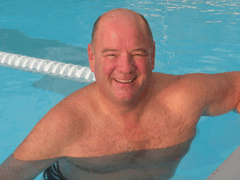Scott Nichols: Beating the Odds
Swimming saved his life after diabetes diagnosis
When you think of the Swimming Saves Lives foundation, what do you think? If you are like many people, you may think of the lifesaving aspect of swimming in terms of drowning prevention. While teaching people to swim safely is a big part of SSL, another way swimming saves lives is by preventing, and in some cases reversing, chronic ailments like heart disease, obesity and diabetes.
To that end, the USMS SSL Foundation is currently supporting a University of Michigan research project on the effects of swimming on chronic illnesses and on how doctors treat those illnesses. The project is also studying the types of self treatment and exercise-enhancing supplements used by people who swim regularly.
Reading about that project prompted Masters swimmer Scott Nichols to write to USMS. Nichols considers himself living proof that swimming does save lives. A member of the Fig Garden Swim Team in California, Nichols, 57, was overweight and the recipient of a new diabetes diagnosis when he decided to do something about it and get back in the water.
Nichols was 305 pounds when he got the news from his doctor. A football player (offensive and defensive line) and swimmer in high school, Nichols says he has “always been a big guy, but the distribution of that weight changed over the years. Plus I gained weight.”
In May 2008, Nichols was taking his daughter to a Masters swim practice and instead of sitting around to wait for her, he decided to join in the fun. “I didn’t know a soul. I just introduced myself and started swimming.”
The first three months were incredibly difficult. Nichols could only swim eight laps at the first practice. He says he asked his lane mates, “When does this start to feel good?” He “Stuck it out because they told me to give it three or four months and then it would feel better. So I knew there was a light at the end of the tunnel. Our coach also stuck with me and was really encouraging and helped me with the new stroke techniques.”
The next practice he swam 400 yards, then made a total of 600 yards in his third practice. In 2009, his wife joined him in the water because she saw his success. She had never swum competitively in her life, and now the couple is known at practice and at meets as Team Nichols.
Nichols says that before he started swimming, his HA1c test results (a common diabetes blood test) were 6.5, which is the point at which diabetes is diagnosed. Now, his number is 5.4, in the healthy, non-diabetic range. He still has to stay on medication, but without swimming, he knows he couldn’t have made the drop in numbers.
Nichols’ doctor told him that he was an anomaly because “of the 1,000 patients he has, I am the only one who is actively using exercise as part of a wellness program. It saddened me that no one else was doing this. The physical consequences of unchecked diabetes are so dire, that’s what got me started.” And he hopes his success will inspire others to join him and make that one in 1,000 number change.
“From my conversations with fellow swimmers in their mid 40s to 50s, it is pretty obvious that a great number of USMS swimmers in that age bracket are swimming to prevent or mitigate a major disease or chronic medical issue. Swimming has literally saved my life, and God willing, I will … be able to stay with it for a very long time.”
In fact, one of Nichols’ long-term goals is to be swimming competitively into his 90s with his wife. His near term goals are to lose twenty more pounds and start competing in some longer events (200 freestyle and 200 breaststroke) and qualify for Spring Nationals. He’s also on track this year to complete 200 miles in the Go the Distance program and looking to do 250 miles in 2012.
Exercise is not a burden for Nichols. “We’re having a heck of a lot of fun.” Nichols says they have a brand new social life too. “I’ve made so many wonderful friends in Masters swimming.”
In short, Swimming Saves Lives in a lot of different ways. Spread the word. And if you want to learn more about SSL and donate to a worthy cause, please visit: usms.org/giving.


